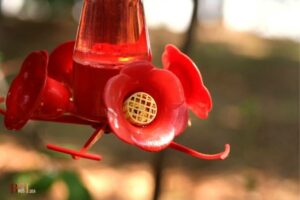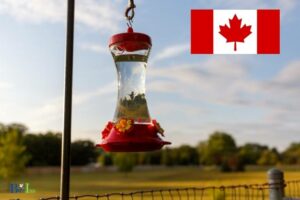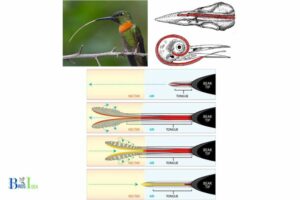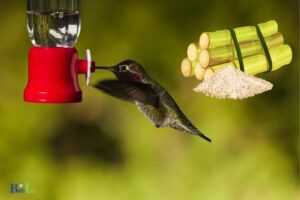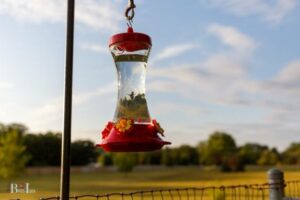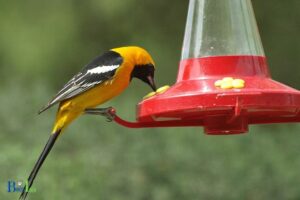Names For A Hummingbird: 10 Popular Names!
Common names for a hummingbird include Ruby-throated Hummingbird, Hawk Moth, White-eared Hummingbird, and Black-chinned Hummingbird.
Hummingbirds, known for their small size and high-speed flight, are named mostly based on their physical characteristics.
Ruby-Throated hummingbird is known for its distinctive red throat, Anna’s hummingbird is named after French duchess, and Rufous hummingbird for their bright rufous-colored feathers.
Allen’s hummingbird is named after the American collector Charles Andrew Allen, and Black-chinned is named for the black coloration on the lower part of their head.
Hummingbirds are an iconic symbol of the Americas and are beloved birds to spot in nature due to their unique behaviors and acrobatic flight maneuvers.
Today, hummingbird populations are threatened by the destruction of their habitats due to human intervention, making conservation efforts more important than ever.
10 Popular Names for Hummingbirds
| S/N | English Name | Latin Name | Region |
| 1 | Ruby-throated Hummingbird | Archilochus colubris | Eastern North America |
| 2 | Anna’s Hummingbird | Calypte anna | Western North America |
| 3 | Black-chinned Hummingbird | Archilochus alexandri | Western North America |
| 4 | Broad-tailed Hummingbird | Selasphorus platycercus | Western North America |
| 5 | Rufous Hummingbird | Selasphorus rufus | Western North America |
| 6 | Blue-throated Hummingbird | Lampornis clemenciae | Southwestern US to Central Mexico |
| 7 | Green Violet-ear Hummingbird | Colibri thalassinus | Central Mexico to Honduras |
| 8 | Sword-billed Hummingbird | Ensifera ensifera | Andean regions |
| 9 | Giant Hummingbird | Patagona gigas | Andean regions |
| 10 | Purple-throated Carib | Eulampis jugularis | Caribbean |
Key Takeaway
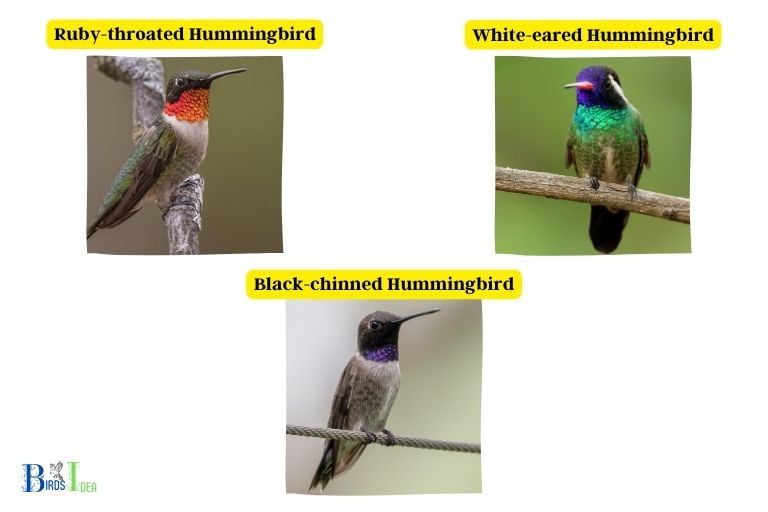
Five Facts About: Names for Hummingbirds
DID YOU KNOW
Hummingbirds range in size from 2–7 inches, with the smallest being bee-sized, and they can flap their wings around 50 times per second.
Common Names for Hummingbirds
Hummingbirds are a group of small birds known for their characteristic flight, which involves rapidly beating their wings in a figure-eight pattern.
They are found in many parts of the world, and due to their unique physical characteristics and behaviors, they have earned a number of unique names from different cultures.

Some of the common names for hummingbirds include:
Hummingbird Hawk-Moth:
This name is used in Europe, and it refers to the hummingbird’s resemblance to a hawk-moth, which is a type of moth with a hummingbird-like appearance.
Sugar Bird:
This name is often used in the southern United States and is based on the hummingbird’s penchant for feeding on sugary nectar from flowers.
Hummer:
This name is a shortened version of the word “hummingbird” and is often used as a nickname in the United States.
Zunzuncito:
This name is used in Latin American countries and is derived from the sound of a hummingbird’s wings.
Colibri:
This name is used in French-speaking countries and is based on the Spanish word for hummingbird.
These are only a few of the many common names for hummingbirds. Each culture has its own unique way of referring to these birds, and many of these names are based on the birds’ behaviors, looks, or sounds.
Anatomy and Physiology of Hummingbirds
Hummingbirds are some of the most fascinating birds in the world. With their quick wings, bright feathers, and ability to hover, it is no wonder why these birds are so beloved.

However, many people don’t know what anatomy and physiology make up a hummingbird. This article will explore the anatomy and physiology of hummingbirds.
Anatomy:
- Beak: Hummingbirds have long, thin beaks with a curved tip that helps them to get food from long, narrow flowers.
- Feathers: Hummingbirds have small, stiff feathers that help them to fly quickly and efficiently.
- Wings: Hummingbirds have long, pointed wings that are adapted for high-speed flight and hovering.
- Feet: Hummingbirds have small feet that are only used for perching.
- Tail: Hummingbirds have a long, forked tail that helps them to maneuver while in flight.
Physiology:
- Metabolism: Hummingbirds have a very high metabolism that allows them to fly faster and for longer periods of time.
- Respiration: Hummingbirds have adapted lungs that allow them to take in more oxygen and expel more carbon dioxide than other birds.
- Vision: Hummingbirds have an excellent vision that helps them to find food and evade predators.
- Feeding: Hummingbirds feed on nectar and small insects. They have a long tongue and a specialized beak that helps them to get nectar from flowers.
Overall, hummingbirds are some of the most amazing birds in the world. Their anatomy and physiology have allowed them to adapt to their
Unique Behaviors and Flight Maneuvers
Birds have unique behaviors and flight maneuvers that can be observed in the wild. Many different species display different behaviors to adapt to their environment, protect themselves, find food, or migrate.

Some examples of bird behaviors include:
- Foraging: Birds often search for food by picking through leaves and grasses, hovering, or diving into the water to locate prey.
- Roosting: Roosting is when a bird sleeps in a group in trees or on a branch, usually at night or in the early morning.
- Migrating: Many birds migrate to different areas in search of food or to avoid harsh weather. Some species of birds, such as the Arctic Tern, will migrate thousands of miles in a single year.
- Preening: Preening is when a bird cleans and cares for its feathers. This behavior helps to keep the feathers healthy and helps birds stay waterproof.
- Territoriality: Birds use certain behaviors to mark their territory, such as singing, posturing, and chasing.
These behaviors help birds survive in the wild, and they can be fascinating to watch.
Beauty is in the eye of the beholder, and hummingbirds are a thing of beauty.
birdsidea
Human Impact on Hummingbird Populations
Hummingbirds are a species of small, colorful birds that are found throughout the Americas and are known for their vibrant colors and unique, high-pitched songs.
Unfortunately, their populations have been declining due to human activities.

Humans have had a major impact on hummingbird populations in a number of ways, including:
Habitat Destruction:
Human activities such as deforestation, urbanization, and agriculture have led to the destruction of the hummingbird’s natural habitat.
This has caused the birds to lose their food sources and nesting sites, making it difficult for them to survive.
Pesticide Use:
Pesticides and herbicides used in agricultural production can be toxic to hummingbirds if they come into contact with them.
This has resulted in a decrease in the hummingbird population as some birds are killed directly and others are affected indirectly.
Climate Change:
Climate change has caused fluctuations in temperatures, precipitation, and other environmental factors, which can impact the availability of food sources and other resources that hummingbirds rely on.
Light Pollution:
Light pollution from streetlights and other lighting sources can interfere with the hummingbird’s natural migration patterns, making it more difficult for them to find food and resources.
Hummingbird populations have suffered a great deal as a result of human activities, and it is important that we take steps to mitigate the impact we have on these birds.
This can include conservation efforts to protect their habitat and food sources, as well as regulations on pesticide use and light pollution.
By taking steps to reduce our impact on hummingbirds, we can help to ensure the survival of these beautiful birds.
Range and Migration Patterns of Hummingbirds
Hummingbirds are small birds that can be found throughout the Americas and in parts of Eurasia and Africa. They have the ability to hover, fly backward, and have impressive migration patterns that span thousands of miles.

Range:
- Hummingbirds are found in the Americas, from Alaska down to Tierra del Fuego, and in Eurasia and Africa.
- In the U.S., hummingbirds can be found in every state except for Hawaii.
- In Canada, hummingbirds can be found in most provinces.
Migration Patterns:
- Hummingbirds have impressive migration patterns that span thousands of miles.
- Some species, like the Ruby-Throated Hummingbird, migrate from their summer breeding grounds in the U.S. and Canada to their winter homes in Mexico.
- Other species migrate between the Caribbean islands or between Central and South America.
- Some hummingbirds migrate along the Pacific Coast, while others migrate through the Mississippi Flyway.
- The Rufous Hummingbird migrates all the way from Alaska to Mexico, a journey of up to 3,000 miles every year.
Overall, hummingbirds are found throughout the Americas and in parts of Eurasia and Africa, and have impressive migration patterns that span thousands of miles.
Conservation Efforts to Help Hummingbirds
Hummingbirds play an important role in the environment, and there are several conservation efforts that can be taken in order to help protect and preserve these fragile creatures.
These efforts include:

Planting a variety of Native Flowers:
Hummingbirds love to feed on a variety of flowers, so planting a wide array of flowers that are native to the area will ensure that there are plenty of options for them to choose from.
Additionally, native flowers are more likely to provide the nutrition that hummingbirds need.
Eliminate the Use of Pesticides:
Pesticides can be very detrimental to hummingbirds, so it is important to eliminate their use or find safe alternatives.
Create Hummingbird Habitats:
Planting trees, shrubs, and other vegetation that hummingbirds like will help create an environment where they feel safe and will be more likely to visit.
Install a Hummingbird Feeder:
By installing a hummingbird feeder, people will be able to observe hummingbirds up close and learn more about the species. Additionally, feeders can act as a supplemental food source for hummingbirds when natural sources are scarce.
By taking these conservation efforts, we can help create suitable habitats for hummingbirds and ensure they will be around for future generations to enjoy.
Symbology of Hummingbirds
Hummingbirds have long been seen as symbols of renewal, joy, and beauty in many cultures around the world.
The hummingbird’s legendary ability to fly backward and hover in midair represents the freedom to choose one’s own path, as well as its ability to dodge obstacles and stay in control.
Native Americans often saw them as a symbol of grace and joy. In some cultures, the hummingbird has been seen as a messenger of good news or even a symbol of resurrection, because of its ability to fly quickly and survive long migrations.

Hummingbirds also symbolize love and friendship due to their affinity for flowers. In some cultures, they are even seen as a symbol of love and loyalty, as they mate and stick with the same partner for life.
The hummingbird has also been seen as a messenger of hope since its small size and agility allow it to fly through obstacles and survive in harsh conditions.
In addition, the hummingbird is a symbol of energy, resilience, and intelligence. Its ability to fly quickly and adapt to different environments is seen as an example of determination and intelligence.
Its small size and fast-beating wings show that even the smallest of creatures can have power and strength.
The hummingbird has been seen as an inspirational symbol in many cultures and continues to be a powerful symbol of joy and hope.
The combination of its agility, resilience, and beauty makes it a symbol of determination and joy in many cultures.
FAQ of Names For A Hummingbird
What is the scientific name for a hummingbird?
Are there different species of hummingbirds?
What is the most common name for hummingbirds?
Are hummingbirds found in other countries besides the US?
Are there different sizes of hummingbirds?
Conclusion
Many of nature’s most beautiful creatures, hummingbirds, are found in the Americas.
They are easy to spot due to their unique characteristics, such as their iridescent feathers and vibrant colors, and their amazing ability to hover and fly at speeds up to 60 mph.
Despite their beauty and resilience, hummingbird populations face threats from habitat destruction caused by humans, and conservation efforts must be a priority for us all.

